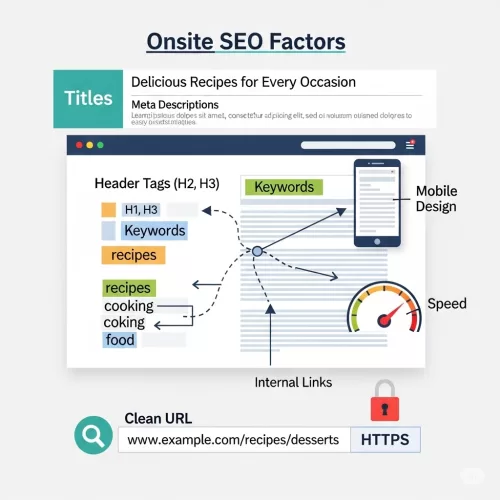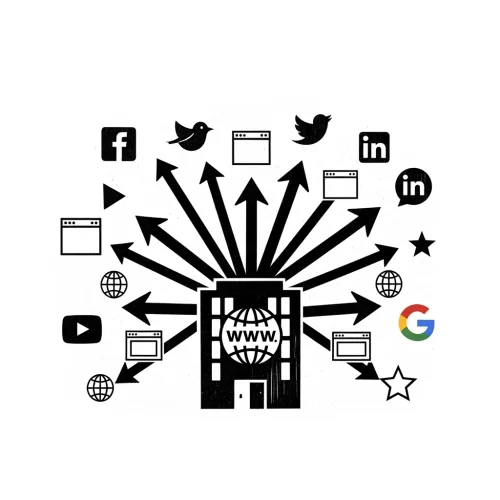Understanding the difference between onsite and offsite SEO is quite essential, if you want to rank higher and build long-term visibility online. These two SEO methods serve different purposes—but they’re both non-negotiable.
Let’s explore how they work, how they affect your performance, and how to combine them into one smart strategy.
1. What Is Onsite SEO? (And Why It’s Your Foundation)

Onsite SEO is everything you can improve on your own website to help search engines read, understand, and rank your content. It’s your structure, your speed, your content—it’s your house.
Key onsite SEO factors:
- Titles and meta descriptions: The first impression in search results
- Header tags (H1–H3): Organize your message for readers and crawlers
- Keywords: Place them naturally in headings and early paragraphs
- Internal links: Guide users deeper into your site
- Mobile design and speed: Keep users from bouncing
- Clean URLs and HTTPS: Help Google trust and index you better
Also important: use structured data (like FAQ schema or review markup) to help search engines extract and display key info about your page.
Bottom line? Onsite SEO tells Google what you offer—and tells users why they should care.
2. What Is Offsite SEO? (The External Signals You Can’t Ignore)

Offsite SEO focuses on how the rest of the internet sees you. It’s about reputation, not just code. Think backlinks, brand mentions, online reviews, PR features—these are votes of confidence from the web.
Offsite SEO strategies that work:
- Backlinks from authority sites
- Guest posts and expert contributions
- Positive reviews on Google or industry directories
- Mentions on podcasts, interviews, or YouTube channels
- Social media visibility—even without links
Offsite SEO shows Google that others trust your brand, recommend your content, and talk about you beyond your domain. That makes your content more rank-worthy.
3. Virtual Identity: Why Your Personal Brand Matters More Than Ever
Here’s a truth that many SEOs miss:
your digital persona influences your offsite SEO—whether you’re a solo creator or a brand.

You don’t have to be a certified expert.
But if your online presence is active, your content is consistent, and your story feels real, you gain credibility by presence.
People trust what feels authentic. Google is learning to trust that too.
“The internet doesn’t reward only what’s true—it rewards what’s valuable, visible, and relatable.”
So even if you’re not running big PR campaigns, your social channels, podcast appearances, or personal story can all strengthen offsite SEO. They build social proof and invite others to talk about you, share your content, and eventually link to your site.
This matters even more if you’re covering topics like sustainability or social impact. In that case:
- Take part in local environmental or charitable projects
- Document the process: photos, behind-the-scenes, reflections
- Turn those into shareable content—blogs, videos, press releases
- Let your values do the marketing
These actions don’t just look good—they get you noticed. And that’s the point of offsite SEO.
4. Onsite vs Offsite SEO: Key Differences You Should Know
Let’s break it down clearly.
| Feature | Onsite SEO | Offsite SEO |
|---|---|---|
| Control level | Fully controlled by you | Influenced, but not fully controlled |
| Focus | Content, structure, speed | Reputation, trust, authority |
| Main goal | Help Google understand your site | Help Google trust your site |
| Tactics | Titles, keywords, internal links | Backlinks, mentions, PR, social |
| Time to see results | Faster if well-optimized | Slower but more powerful long-term |
Onsite SEO tells your story. Offsite SEO gets others to talk about it. You need both for long-term success.
5. The Role of Content in Both Onsite and Offsite SEO
Content drives everything. But the way it works for onsite and offsite SEO is different.
For onsite SEO:
- Create helpful, keyword-rich content that solves specific problems
- Use clear structure, short paragraphs, and strong internal linking
- Focus on user experience—not just bots
For offsite SEO:
- Create content others want to share—like original research, opinion pieces, or case studies
- Pitch your story to niche blogs, journalists, or podcast hosts
- Turn real events (charity efforts, product launches) into media-worthy narratives
One strategy that bridges both worlds: use your brand values as a story engine. For example, if you’re running a sustainable product line, don’t just say it. Show the process. Write about it. Share the journey.
That kind of content builds trust, earns mentions, and gets links naturally.
6. How to Combine Onsite and Offsite SEO for Maximum Impact
Start with what you control—your website. Optimize it with smart content, good speed, and clean structure. Then expand outward.
Here’s how to combine both for long-term wins:
- Audit and clean up your website regularly
- Create shareable content that offers value beyond your site
- Build real relationships with people in your niche
- Engage on social media as a human, not a brand robot
- Use storytelling to humanize your brand across all platforms
SEO isn’t just technical anymore. It’s personal. It’s social. And it’s ongoing.
The best strategy? Keep showing up, online and offline. Offer something real. Let others amplify it.
Final Words: The Smartest SEO Strategy Uses Both
Knowing the difference between onsite and offsite SEO helps you work smarter, not harder.
You build your foundation through onsite SEO.
You earn trust and expand your reach through offsite SEO.
When they work together, your site doesn’t just rank—it grows.
Want long-term visibility? Be clear inside your site. Be loud outside of it.

Leave a Reply